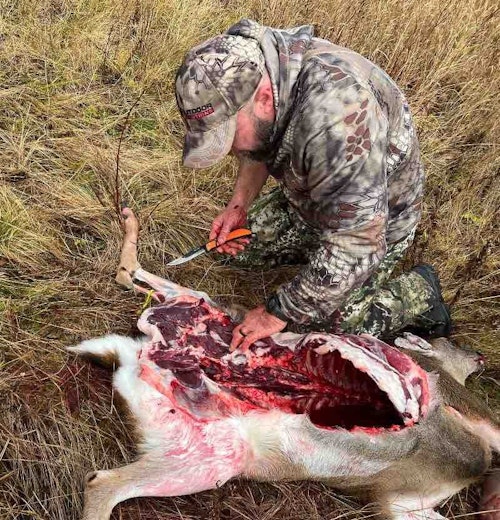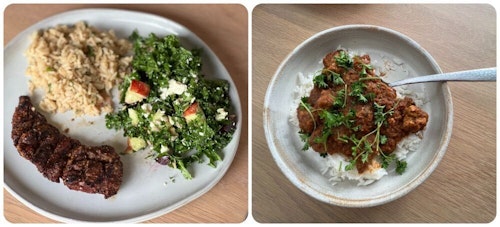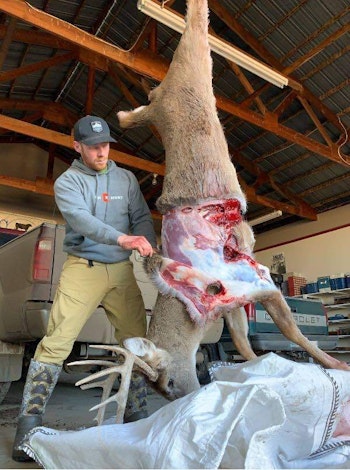Heaps of snow covered the western landscape. The cold-for-October temperatures were beginning to grip me. About 15 feet up a tree, the shivers paid me a visit. I don’t typically look for reasons to cut a hunt short, but I’ll admit that I did that morning. That’s when the perfect reason to end my hunt came walking down a trail 30 yards over my shoulder.
Slowly I stood and grabbed my bow from its hook, then carefully shifted nearly 180 degrees to position for the shot. Right when I began drawing my bow on the lead doe, the four deer in the group bolted because they’d smelled me. I mouth-grunted, which stopped one doe perfectly broadside. I floated my 30-yard pin on her side, and my expandable broadhead blasted through like a hot knife through butter. She bolted for about 80 yards and toppled over.
I can count on one hand the number of times my wife and I have bought grocery-store beef. From Mexican to Moroccan and Chinese to the classic American hamburger, venison is a prodigious part of our overall lifestyle and the base for weekly culinary explorations. So, you can imagine how excited I was to secure a doe for the freezer on that ice-cold October morning.
Harvesting a deer, elk or pronghorn is a cherished event in the McDougal world. Having studied the way the commercial meat industry does things makes me prouder than ever to be a hunter. Wild animals get to roam freely rather than be confined to crowded pens, cages, barns and feedlots. Taking out a deer, elk or pronghorn with a single, well-placed arrow is also more humane than practices I’ve observed in documentaries about the meat industry.
Being the meat provider of the household is a big responsibility, so I take the entire process very seriously. From the moment I decide to harvest an animal to the moment it hits the pan or grill rack, the decisions I make affect how well my venison serves up. I’ve eaten gamey venison, and it’s not the easiest to swallow. But, it doesn’t have to be that way.

From Field to Table
Whether you’re ready to tighten up your venison care, or you’re new to hunting and don’t quite understand exactly what to do after you put a deer on the ground, here are five tips for great-tasting venison.
1. Take Responsible Shots
Believe it or not, proper meat care begins the second you decide to release an arrow. A well-placed shot — through the heart and/or both lungs — always yields the best results. Hit elsewhere, however, and game meat can inherit poor flavor or become boot-leather tough.
For example, a gut-shot deer gasses up internally over the 6-12 hours it takes to expire, continuing until you recover it. You know that awful smell when you accidentally pop the stomach while field-dressing a deer? Well, that smell is essentially leaking all throughout the cavity following a gut hit, and essentially marinating (not in a good way) the meat. Another example is an animal hit marginally and requiring pursuit and follow-up shots. The farther an animal runs, the more you risk tough meat.
Knowing this, do your part to take deer with a single, well-placed shot through the heart or both lungs. That is the first important step to ensuring great-tasting venison.
2. Recover the Animal Quickly and Get to Work
“Now the work begins” is the adage referencing caring for meat after successfully harvesting an animal. Yes, it’s a lot of work, but for venison-dependent folks like me, it’s a labor of love. The first step is to recover the animal as quickly as possible — particularly when it’s warm — after waiting the appropriate amount of time based on the hit you made.
If the carcass isn’t accessible by vehicle and dragging it to a road or vehicle isn’t possible, the meat will have to be packed out, either boned or in quarters. In this instance, you’ll immediately be harvesting meat from the carcass, so field-dressing the animal isn’t necessary. You can get every usable meat cut, even the tenderloins, from the carcass without field-dressing. Meat should be transferred to an antimicrobial game bag, such as those from Koola Buck.
In contrast, if you’ll be dragging the carcass or otherwise moving it from the field to a suitable skinning and butchering location, field-dress it to prevent bloating and gassing inside the chest cavity, thus allowing the carcass to cool down. Do this carefully, and avoid contaminating the meat with urine, guts and fecal matter. And, if your knife contacts any such bacteria, be sure to wash it or use a different knife before proceeding. Failure to do so can speed up meat spoilage.

After field-dressing, drain as much blood from the chest cavity as possible. In colder temperatures, wedge a sturdy stick in the chest cavity to keep it open so that it cools down fast. If it’s warm, get a bag of ice inside the chest cavity to cool down the carcass. I did this when I shot a whitetail buck in Nebraska in 85°F temps. The carcass cooled nicely overnight, and I skinned and butchered the following morning. The meat stayed perfectly fresh. If you have some type of walk-in cooler the animal can hang in, even better.
3. Skin and Debone
As you prepare to skin your kill, either wash and sanitize the knife you used to field-dress the animal or use a different one altogether so as not to introduce contaminants to the meat. When you get the carcass of a deer or pronghorn to a suitable skinning location, hang it up. If the skinning location isn’t temperature-controlled and has the potential for flies and other contaminants, begin skinning immediately. If you must wash the carcass after skinning, be sure to let it dry sufficiently before harvesting cuts of meat. Meat should be kept cool, clean and dry from field to freezer.
Some hunters, especially in cooler weather, hang their deer for a few days before skinning, butchering and processing. Others skin and then allow the carcass to hang. This “aging” technique uses enzymes naturally in the meat to tenderize muscle fibers. However, I believe the meat can inherit unwanted flavors if hung outdoors or even in a garage. So, I don’t age my venison. Maybe I’m missing out on something, but I’ve had good luck with skinning and deboning as quickly as possible.
When I debone the meat, I transfer it to an ice-filled YETI Tundra cooler. I place it directly on the ice, and I’m a good steward of draining water so the meat doesn’t sit in it. A mistake I’ve made in the past was to put meat directly into zip-top bags and close them up before dropping them into my cooler. The heat from the meat causes condensation, which becomes trapped in the bag. I’ve noticed that this yields a poor flavor. Now, if I put meat in bags, I wait to zip the top until the meat has fully cooled down. But, I usually put the meat directly on the ice and keep the melted ice drained.
4. Package and Freeze
Meat on ice in a high-quality cooler such as the YETI Tundra can last for at least a week. But, it’s always best to keep tabs on the ice and drain the cooler. If I can’t get to processing the meat for several days, I’ll prop the end of the cooler opposite the drain into the air and then leave the drain open so that the meat doesn’t go for a swim. And, I don’t prolong packaging any longer than I must.
Properly packaging and freezing your venison will lengthen its edible life. I package ground venison in 1.5-pound burger bags, which are available at farm supply or sporting goods stores that offer meat grinding equipment. I package loins, steaks and roasts in freezer paper or ideally in vacuum-sealed bags using my LEM MaxVac 500 Vacuum Sealer. I carefully label each package with its contents and date for easy reference later on as I make routine trips to the freezer.
Once the venison has been packaged, I place the packages into the freezer. I try to turn them every few hours — if packages must be piled on top of one another — to ensure fast and even freezing. Once the packages are frozen solid, the work is over and you get to finally enjoy the fruits of your labor.

5. Eat It
Even properly-packaged venison lasts only so long in the freezer. If you have a freezer designated specifically for meat, it will likely maintain its excellent flavor longer. If you have other items in the freezer, I believe the venison can potentially take on flavors from the freezer’s other contents.
Regardless, I like to use up venison within 1 year, if possible. This generally isn’t a problem since my wife and I don’t buy beef. And, during years when I harvest more game than we can consume in a year, we bless family and friends with some of the meat so that we aren’t hoarding it and allowing it to become freezer-burnt.

A Labor of Love
Few hunters are experts at butchering and processing wild game. For that reason, most take the easy route, dropping their harvested deer off at a meat-processing plant. It’s the easy thing, right? I used to do this more than a decade ago, but questions invariably lingered. How is the meat handled and by whom? How sanitary are the tools and surfaces the meat contacts? Is the meat cross-contaminated with other meats, or is each handled one by one? For that matter, am I even getting my own venison back?
I’m a provider, and that’s why I proudly put in the work after a successful hunt. My wife, family and I handle my deer and other game meat from start to finish. We take pride in every facet, and the result is delicious red meat that couldn’t be more fulfilling to eat. And dinner guests don’t think twice when they eat it because it tastes great.
I see every harvested animal as a gift from God, and that’s why I take immense pride in every step of the field-to-freezer process. If you’re tired of the questions that linger when you drop off your harvest at a processor, you’re tired of eating “gamey” venison, or you’re new to hunting and are curious about how the after-kill duties look, follow the keys to great-tasting venison outlined in this article.
Sidebar: Proven Tools for Meat Care
Keep meat spoilage at bay with a top-notch hard-sided cooler. Today’s hunter has many brands from which to choose — Engel, Grizzly, ORCA, RGD, RTIC and YETI just to name a few.
I have in-the-field experience with YETI’s Tundra Series. The Tundra’s fatwall design contains up to 3 inches of pressure-injected polyurethane permafrost insulation to help ice and meat last longer. Its interlock lid system and coldlock gasket maximize ice retention, allowing your venison to remain fresh for days. The vortex drain is leakproof and simplifies draining duties. Several sub-models of different capacities allow you to choose the ideal size for the game you pursue. Contact: www.yeti.com
Outdoor Edge offers a gamut of tools for breaking down your kill. I’ve skinned and quartered elk, hogs and deer with as little as the RazorLite 3.5-inch EDC replaceable-bead knife, but I really love the lightweight and packable RazorGuide Pack, which features two replaceable-blade knives with several blade options and also a Flip N Zip Saw. It comes in a folding pouch that keeps the tools organized and takes up little space in a backpack. It works incredibly well for every step of field care and then processing, and it also allows you to keep working with sharp blades without the need to sharpen — slip in a new blade and keep working! Contact: www.outdooredge.com
Koola Buck understands that fresh is best, which is why its game bags are antimicrobial. Choose from different bag sizes appropriate for the game you hunt. Koola Buck’s Anti-Microbial cotton-poly game bags are treated with natural and flavorless acids derived from fruits and other bacteria inhibitors. Not only do these game bags keep venison safe from flies and other contaminants, but they also keep spoilage at bay with eight times the bacteria reduction of regular untreated game bags. Contact: www.koolabuck.com

Sidebar: A Little Extra Effort Goes a Long Way
When I’m processing venison, I don’t merely separate the cuts and package them. I spend time with every single cut to remove hair (I use a tweezer; photo above), fat and silver skin. It takes a lot more time, but when my wife or I pull out a package of frozen venison, we know that it’s ready to be seasoned and cooked. Spend more time while processing to save time in the kitchen preparing the meat.
Photos by Darron McDougal







